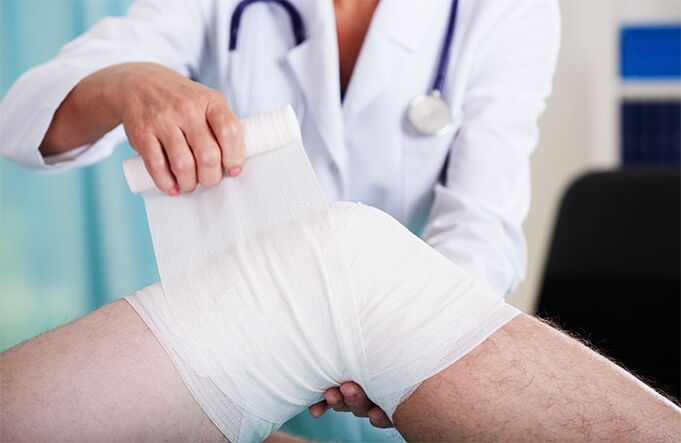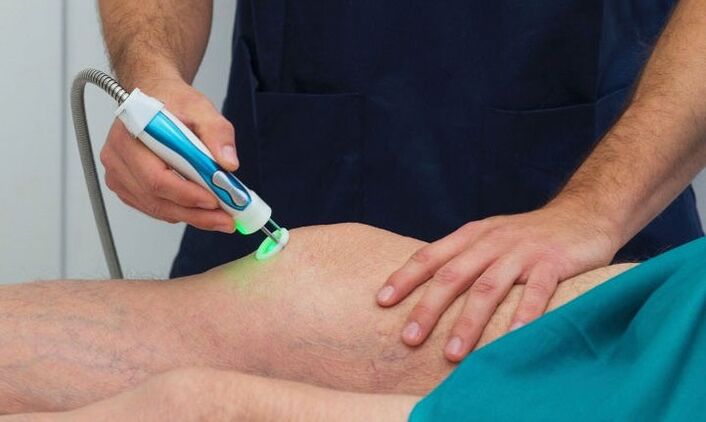
If you hear a crunching sound in the knee joint during movement, this is the first sign of gonarthrosis. The conservative methods of traditional and alternative medicine will help prevent cartilage destruction and maintain normal motor function. Treatment should begin immediately - only in this case will the rheumatologist give a favorable prognosis.
What is gonarthrosis?
A non-inflammatory, degenerative-dystrophic disease that affects the largest joint, the knee, is called gonarthrosis. A rather unusual medical definition, there is a simpler "folk" concept - "deposited salt". Although the clinical picture of joint gonarthrosis has little to do with excess calcified salts in the knee joint. They do not have any effect on pathology and are a side effect of impaired metabolism.
The development of knee joint gonarthrosis is facilitated by negative processes in the hyalinized cartilage, mainly poor blood circulation in small bony vessels. Lack of nutrients and oxygen due to the influx of lymphatic vessels leads to destruction of the outer cartilage layer of the knee.
In the early stages, the disease is extremely difficult to recognize. Joint deformity occurs slowly, until the vitrified cartilage is withdrawn in the process. The anatomical structure of the ligament is modified. Turbidity occurs, the tissue thickens, becomes thin, cracks in all directions. The result of pathology can be a complete disappearance of the cartilage, leading to a tumor on the bone tissue and irreversible curvature of the knee.
Classification of diseases
The International Classification of Diseases divides gonarthrosis into seven clarifying subheadings:
- Bilateral primary gonarthrosis. Diagnosis is usually made in women aged 70 to 74 years and men aged 60 to 64 years. This classifies the disease as an "elderly" disease.
- Another major gonarthrosis. Pathology of a knee joint, due to natural wear and tear or to the background of other diseases.
- Gonarthrosis after bilateral trauma. People of different ages with serious foot injuries are affected.
- The gonarthroses after trauma. Unilateral, against wounds and bruises of the extremities.
- Other secondary gonarthroses are bilateral. They are the result of chronic bruises, fractures or dislocations that are not completely cured. It is often diagnosed in athletes who are subjected to heavy loads on both feet - football players, athletes, figure skaters.
- Other secondary gonarthroses. Unilateral development of occupational-related pathology. For example, miners, metallurgists, fishermen.
- Gonarthrosis, unspecified. It was diagnosed with an unexplained etiology of the disease, after excluding age, occupation, and genetic predisposition.
According to medical statistics, more than 10 million people of different age groups suffer from gonarthrosis of one type or another. Every year, about 3, 000 people with a confirmed diagnosis die.
Reason
Knee osteoarthritis develops due to impaired metabolism in the knee joint, resulting in cartilage loss of softness and elasticity.
Destructive processes are caused by various reasons:
- Diseases of the thyroid gland, violation of the hormonal background;
- Decreased blood vessel flow in the knee joint;
- genetic regulation;
- natural aging;
- Past or present knee injury, of various origins;
- Obesity (more than 20% of the norm), puts a lot of pressure on the knee joint;
- Arthritis diseases (polyarthritis, purulent joints);
- Autoimmune diseases (rheumatoid arthritis);
- Specific infectious diseases (syphilis, tuberculosis, encephalitis);
- Live in areas that are ecologically unfavorable, with poor quality of food and water.
In addition, rheumatologists identify several more reasons that lead to the development of gonarthrosis. Neonatal dysplasia. With this diagnosis, the joint wears out faster. Changes in the structure of collagen lead to a violation of proteins located in the connective tissue.
Symptoms depend on the degree of gonarthrosis
It is difficult to diagnose the early stages of knee effusion. Only a description of the patient's own symptoms and an external examination by a rheumatologist can draw a different clinical picture for each degree of gonarthrosis progression:
- I degree gonarthrosis.Persistent pain in the knee, feeling of stiffness, partial loss of sensation, difficulty flexing the leg, especially after prolonged immobilization, inability to walk or run for a long time, mild swelling. As a rule, symptoms disappear after rest or a simple anesthetic is administered.
- Grade II gonarthrosis.At this stage, X-rays alone can identify the pathology. The pain becomes stronger and appears after each physical activity. Discomfort can still be relieved by rest. In the morning, it becomes more difficult to straighten the legs, taking some time to recover motor function. The discomfort is complemented by frequent cramps in the calves, especially at night. During the movement, a crackling sound is emitted. Noticeable swelling of the knee joint. There are obvious signs of limb deformity.
- Grade III of gonarthrosis.There are irreversible changes in the knee joint. Cartilage abnormalities can be unmistakably identified on x-rays. The pain in the knee becomes constant, acute. The leg stops bending at the knee. The patient cannot walk without a cane or crutches. The swelling is significant. The anatomical shape of the knee is smoothed and looks solid. There is a major curvature of the spine.

Diagnose
For an accurate diagnosis, a combination of the clinical manifestations of knee osteoarthritis and patient complaints is used. To clarify or rule out the causes of the disease, studies are carried out in different ways.
The standard diagnosis is as follows:
- Create a history of the disease. History of comorbidities, genetic predisposition, past trauma and surgical interventions, professional operations, etc. v.
- External assessment of deformities of the musculoskeletal system. gait, posture, state of the knee joint, curvature of the leg.
- General check. Feel the affected leg, thigh, and joint area to determine the location of the disease.
- Laboratory tests. A general blood test provides data on the absence of an inflammatory process. If this process takes place against the background of other diseases, the erythrocyte sedimentation rate will increase in the blood. Protein, globulin and fibrinogen levels will differ from the normative readings. Biochemical composition will remain within standard limits. If the pathology is advanced, a biopsy of the knee synovial tissue will be performed.
- Research tools. X-rays are the primary and most common method for diagnosing suspected gonarthrosis. As a rule, the rheumatologist can easily identify changes in the structure of bone tissue from a picture already in the early stage 2 of the disease. The presence of secondary diseases and the cause of their occurrence is diagnosed with the help of more modern and accurate equipment - MRI, CT, ultrasound, bone scan, temperature.

Treatment of gonarthrosis
Like all diseases of the joints, gonarthrosis requires systemic treatment, treatment should begin when the first symptoms appear. In this case, the prognosis of therapy becomes favorable and ensures a return to a normal lifestyle in a fairly short time.
Comprehensive treatment is aimed at eliminating the main signs of the disease:
- Discomfort, pain syndrome and muscle tone;
- Improves the mobility of the knee joint;
- Stop the destruction of cartilage;
- Strengthens the connective muscles;
- Restores normal blood circulation in the knee joint.
Medicine
Anti-inflammatory drugs
They help reduce pain, reduce swelling caused by inflammation of muscle tissue.
Chondroprotectors
Regeneration and restoration of cartilage tissue is impossible without chondroprotectors. They are the main component of conservative treatment.
Vasodilators
They are used to improve the intelligence of intra-articular blood vessels.
Endocrine drugs
Reduces the production of the hormone cortisone, to prevent the development of inflammatory processes.
Inject hyaluronic acid
Used to restore intra-articular synovial fluid. As a result, the friction between the joint parts is reduced, the motor function is normalized, and the elasticity of the cartilage tissue is restored.
Anti-Enzyme
They inhibit the action of trypsin, thereby preventing joint destruction. Designated in the complex.
Physical therapy
Physiological treatments have been successfully applied for decades to treat osteoarthritis of the knee. It can be as a separate type of therapy, either for prevention or during rehabilitation. So does the integrated approach to the disease.
Typically, the following types of procedures are prescribed by a rheumatologist:
- Electrophoresis with analgesia;
- Treatment with ultrasound;
- Magnetic therapy;
- Exposure to laser beams;
- Paraffin application;
- Sludge treatment;
- Exercise therapy (exercise therapy);
- Manual therapy, massage with ointment.
Surgery and prosthetics
If the warts are in an advanced stage, the knee joint and cartilage tissue are destroyed, it cannot be done without surgery. Otherwise, the person will be disabled for life.
Modern medicine offers several ways to deal with the problem:
- Joint foot. Complete removal of affected tissue and knee joint. The body is freed from the focus of the disease, but the motor function of the limbs is completely lost. It is very rarely used, if the patient has additional diseases of the joints.
- Arthroscopy. Remove destroyed hyaline cartilage. The surgery is less traumatic and has a short recovery time. It is indicated for patients whose progression has not yet affected the knee joint.
- Circumferential bone cutting. A complex surgery, the essence of which is to fix the bone and the deformed part of the bone, with subsequent connection into the necessary anatomical structure.
- Endogenous drugs. The completely destroyed knee joint was removed and a titanium prosthesis was placed in its place. An effective method that allows you to forget about gonarthrosis forever. Requires thorough preparation and long recovery.
Traditional medicine
The use of folk remedies in combination with conservative treatment can relieve external symptoms (pain, swelling). Recipes based on bay leaf, burdock root, St. John's, malt and hay have proven to be good. Ointments, creams, tinctures and decoctions are made from them.
These plants have anti-inflammatory and pain-relieving properties. Requires regular and long-term use to achieve visible results.
Ointments and compresses made from honey, with the addition of alcohol or apple cider vinegar, soothe swelling and have a soothing effect on affected tissues.
Nutritional blend made from lemon and garlic, taken orally, per teaspoon, after breakfast and dinner. Such a formula has a general strengthening effect on the body, increases the circulation of blood vessels and nourishes the joints with useful trace elements.
It should be remembered that home treatments do not eliminate the main problem - the pathological destruction of the knee joint.

Diet
Compliance with the diet is an integral part of a complex treatment. Adjusting the diet not only helps to control weight, but also provides essential vitamins for bones and joints.
For a patient diagnosed with gonarthrosis, it is contraindicated:
- Fried, spicy, salty, sour foods;
- Fatty broth;
- Cake;
- Fruit, which has a high content of acidic enzymes;
- Acoholic drink.
The menu should include raw vegetables, fruits and herbs, low-fat yogurt, bone broth and gelatin dishes (jelly, jelly).
Additional method
To treat gonarthrosis, regular spa treatments are required, at least once a year, if possible more often. Hydrotherapy, mud therapy, and manual therapy can preserve disease in the long run and prevent joint destruction.
It will take the rest of your life to keep your knee pain stable. But it can turn out to be quite helpful for the body in general. Reviewing your diet, eliminating bad habits, playing sports, visiting resorts - quality of life can improve dramatically.
It should be remembered that self-medication, ignoring the initial symptoms and succumbing to the stress of a painful knee joint can very quickly turn a healthy person into a helpless disabled person.






























